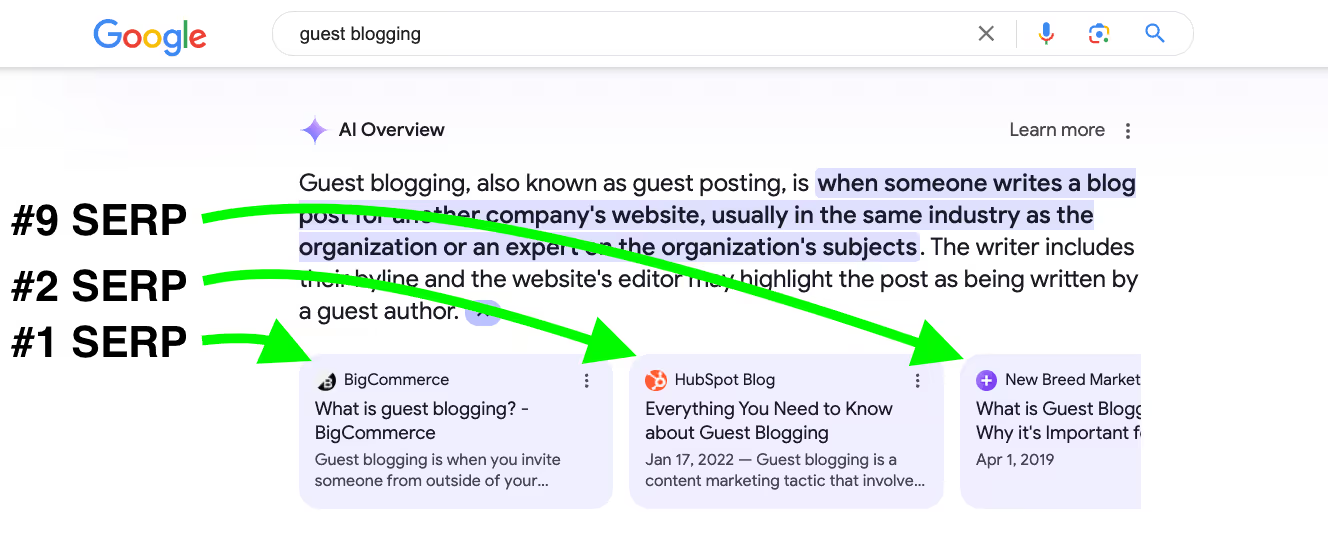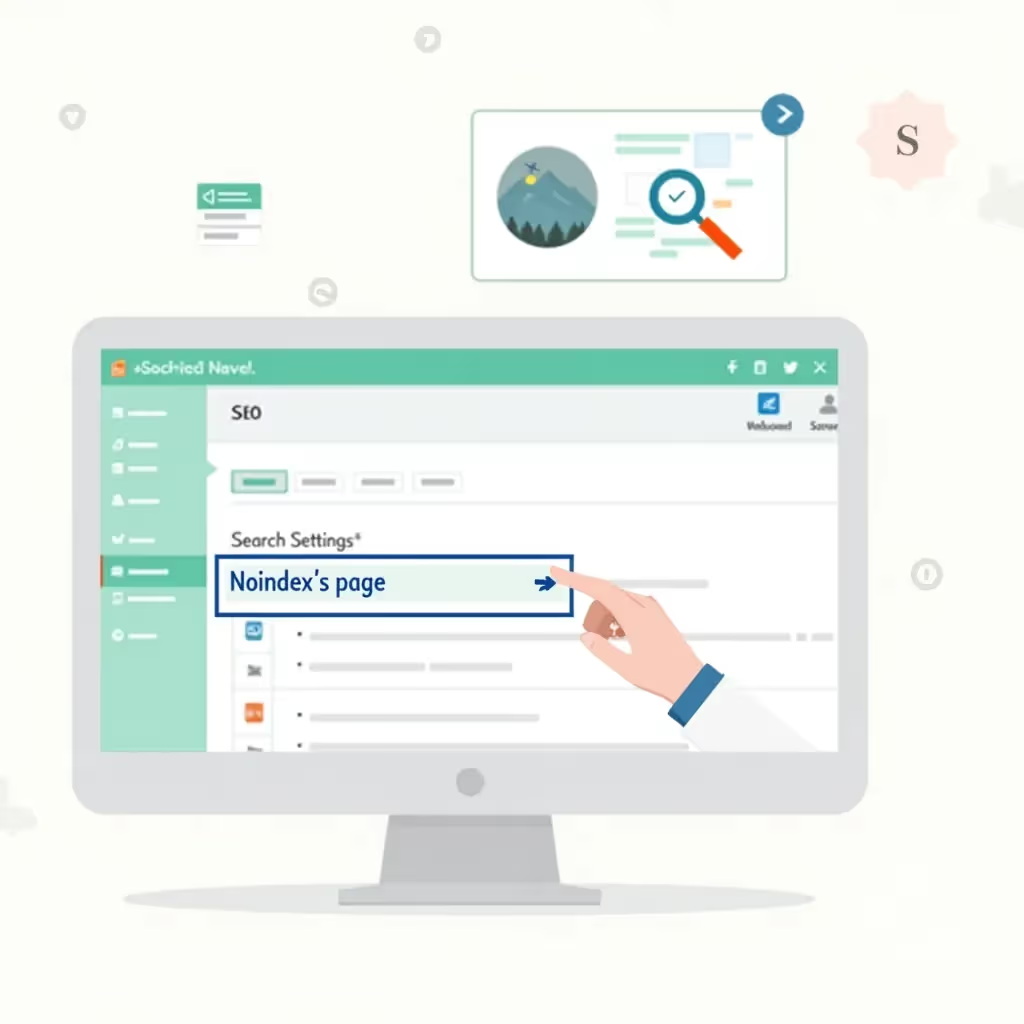One of the things that I love about search engine optimization (SEO) is that it’s always changing. And Google’s new AI Overviews are certainly one of the biggest changes to search engine results pages (SERPs) since I started doing SEO.
In May 2024, Google launched AI Overviews, without opt-in, to provide searchers with a generative AI experience within search. In its testing, Google found that AI Overviews are helpful for searchers who need to get an answer quickly and who might benefit from a variety of sources.
If you’ve searched lately, you’ve likely seen an AI Overview. Here’s an example:

Google’s AI Overviews can appear in various places, such as above the sponsored listings on SERPs. They can also appear below the sponsored listings and alongside other SERP features, like featured snippets.
Google’s AI Overviews are similar to the search experience provided by Perplexity, a competing search engine that pioneered generative-AI answers alongside source links:

Perplexity’s search engine shows results similar to Google’s AI Overviews.
Website publishers were automatically opted in to AI Overviews, and unless you instruct Google not to consider your website for AI Overviews, you might already be appearing within them. More on that later.
As a website publisher, I was initially pretty fearful about AI Overviews and the potential traffic loss to my website. But today, I’m excited about AI Overviews.
In this blog post, I’ll explain how I’m thinking about AI Overviews today and what I think the future holds.
Components of AI Overviews

AI Overviews often highlight, in purple, a brief definition or explanation, in an attempt to provide a quick answer to a query.
Google will provide two or three SERP results directly below the AI Overview answer, alongside a couple of different expansion options. Once expanded, the AI Overviews will take up significantly more real estate on the first page of search results:

Users can then use the purple dropdown arrows to further expand the answers, and Google will show more specific SERP results highlighting where that information was pulled from.
In other words, depending on how many times a user expands the AI Overview, they will see more or fewer SERP results, and the SERP results may be different, depending on which section has been expanded.
AI Overviews vs. Featured Snippets
Initially, I was pretty surprised to see AI Overviews appearing alongside featured snippets:

I would have thought that Google would entirely replace a featured snippet when an AI Overview was present, but that does not appear to be the case.
This is surprising to me for two reasons:
- There appears to be quite a bit of information overlap between AI Overviews and featured snippets. In the example above, we see that BigCommerce appears with similar information in both places.
- The rest of the search results get pushed down even further. For this query, we’ve got sponsored ads, AI Overviews, a featured snippet, and then finally the organic search results.
So right now it appears that you can be featured in both locations; however, we don’t yet have data to suggest whether AI Overviews will draw more or fewer clicks than traditional featured snippets.
Eventually Ads
As part of the launch of AI Overviews, Google reiterated that Google ads will continue to appear alongside AI Overviews and will be clearly labeled as such.
Google is also planning to integrate search and shopping ads into AI Overviews.

Source: Google Ads & Commerce Blog
For example, if someone searches for something like “change battery in Timex watch,” Google could cleverly explain how to do that with an AI Overview, and then inject a Google Ad for the specific type of battery directly within the AI Overview. Time will tell, but this could be very exciting from a paid point of view if it allows us to better target ads to specific queries.
Impact on SEO, Click-Through Rate & Reporting
As SEOs, we knew that AI Overviews were coming. Google’s Search Generative Experience (SGE) was released in 2023, and it was clear that Google was considering launching generative AI into its search engine. In May 2024, Google changed the name from SGE to AI Overviews.
Today, AI Overviews are appearing without opt-in for many US searchers, and Google expects to roll out AI Overviews to searchers globally soon.
AI Overviews are similar to SGE results but generally much smaller and resemble a traditional featured snippet.
Effects on Click-Through Rate
I have a love/hate relationship with SERP features like featured snippets (“position 0”), and People Also Ask (PAA). These features often reduce the number of clicks to publishers from the SERPs, but in other cases, they actually increase the number of clicks to publishers. For example, if you jump from the seventh spot for a given keyword to position 0 with a featured snippet, odds are you’ll get more traffic back to your website.
Most of the SEO community was waiting fearfully for the release of SGE, now AI Overviews, as there had been a lot of speculation that the AI Overviews would reduce the click-through rate (CTR) from search results to websites, thus reducing the amount of traffic website owners could get for given keywords.
Early analysis from Kevin Indig found that when a website was cited in an AI Overview, it experienced an 8.9% decrease in organic search traffic. This analysis also found that when AI Overviews were present for a given keyword but the domain wasn’t cited, there was a 2.8% drop in search traffic.
However, in an interview with Barry Schwartz at Search Engine Land, Hema Budaraju, Google’s Senior Director of Product, Search Generative Experience, told Schwartz “that the link cards within AI Overviews generate a higher click-through rate than traditional web search results.” Budaraju went on to compare the CTR increases from AI Overviews to the CTR increases that website owners will often see from featured snippet placements.
While many SEOs including myself were surprised to hear a Google spokesman describe AI Overviews as a positive for publishers, this wasn’t the first time that I’ve heard such a statement from Google.
In 2023, at the BrightonSEO conference in San Diego, I listened to a talk with Danny Sullivan, Google’s Public Liaison for Search, during which he stated that Google isn’t trying to take away traffic from publishers and that this is something they are hyper-aware of. Sullivan went on to reiterate that sourcing would be provided back to publishers in any AI-based SERP features, and that is exactly what we’ve seen with the rollout of AI Overviews.
Within an AI Overview, there are multiple ways for a searcher to click through to a publisher:

Google will display cards hyperlinking to publishers immediately at the top of an AI Overview. But when an AI Overview is expanded, Google also provides links back to publishers.
It’s unclear how often these AI Overviews will be appearing in search results, and in the interview with Schwartz, Budaraju declined to provide that data.
However, very early indications suggest that AI Overviews aren’t everywhere yet. As of this writing, Semrush’s Sensor suggests that AI Overviews are appearing in less than 1% of search queries in the U.S.
Moreover, in another analysis, ZipTie.dev found that Google was displaying SGE in fewer and fewer search queries ahead of the rollout of AI Overviews:

Source: ZipTie.dev
On the Optimize podcast, we talked with SEO consultant Eli Schwartz, who mentioned that he believes keywords serving very evergreen or informational queries are most likely to be impacted.
In my searching, I’ve noticed that AI Overviews don’t appear as often for very transactional keywords. Moreover, Google might be slower in rolling out AI Overviews to Your Money or Your Life (YMYL) queries due to the heightened risk of an inaccurate AI Overview impacting someone’s livelihood. As of this writing, Google displays AI Overviews for YMYL queries with a disclosure.
You Won’t Get Specific Reporting in GSC (for Now)
Unfortunately, Google has said that they won’t provide ranking, CTR, or traffic data for AI Overviews specifically in Google Search Console (GSC).

Google’s John Mueller was asked about Google providing AI Overview data in GSC, and he reiterated that Google’s decision not to provide this data separately is in line with how they handle other SERP features, including featured snippets.
Mueller and Budaraju did say that you will see clicks and impressions data from AI Overviews, within GSC, but that this data will be grouped into existing GSC data and you won’t be able to separate out performance from AI Overviews.
Never say never. Given the pushback from publishers, it is possible that Google could in the future offer more specific performance data for AI Overviews — as in the past, they had been planning to offer similar functionality for featured snippets, it was just never released.
If AI Overviews Improve Search for Searchers, They Will Likely Search More Often
Google obviously believes that AI Overviews will improve the quality of search for searchers. Delivering helpful information from a variety of top sources quickly should help searchers find what they’re looking for faster and might not require that the searcher click on multiple search results back to back to back.
Generally, if searchers have a great experience when searching in Google, they will be more likely to come back to Google the next time they have a question.
On the Optimize podcast, Brian Dean, the founder of Backlinko, mentioned that he doesn’t see the rollout of SGE (now AI Overviews) as a threat to conventional SEO, and that it might even be beneficial. He adds that this change could be similar to the rapid growth of mobile computing. Back then, SEOs feared that mobile search would reduce traffic to publishers.
“That was a big scare back in the day,” he said, “because of the alignment of the screen. It pushed the organic search results even lower down below the fold of this mobile screen. And that was the ‘death of SEO’ because you were going to be even lower than you were before. But what people didn't take into account is people will be searching more because they'd have their phones with them all the time. So it more than made up for that.”
One could argue that if AI Overviews substantially improve the quality of search, then searchers will search more often. We are speculating here, but despite what Google has said, one could further argue that AI Overviews might reduce the CTR back to publishers for any given search. At the same time,publishers might be better off as a whole if the total number of searches increases in a meaningful way on the platform.
In other words, if AI Overviews improve search substantially, and that increases usage of the platform, then publishers might stand to benefit, with more traffic overall heading back to their website.
However, There Have Been Some Accuracy Issues
Google has acknowledged that with the rollout of AI Overviews there will be some issues with accuracy, and that this is something they will be looking to improve quickly.

As just one example, in a recent AI Overview, Google suggested making chlorine gas, which would be very harmful and potentially life-threatening for searchers.
Optimizing for AI Overview Placement
I wouldn’t listen to any SEO making specific recommendations on how to optimize for placement in AI Overviews, at least as of this writing, given how new AI Overviews are in the search landscape.
That being said, from my own searching, it appears that the AI Overviews are largely being powered by the first page of search results:

Our website is ranking fourth for the query shown above, and it just so happens that Google is displaying an AI Overview for this query in search results.
I noticed that with this query specifically Google is pulling in three SERP results as sources for the AI Overview. It just so happens that all three of these sources are currently ranking on the first page of search results, in the first, second, and ninth positions.
As discussed on the Optimize podcast, Matt Lenhard found that webpages ranking highly in Google’s normal organic search results were more likely to be pulled in as sources into an AIO. Matt’s analysis found that the #1 search result was 55% more likely to be pulled in as an AIO source versus the #2 search result. As another example, the #2 search result was 90% more likely to be pulled in as an AIO source versus the #9 search result.
Matt also found that the sources included in AI Overviews had text high in cosine similarity to the text displayed in the AI Overview itself, which aligns with a recent patent from Google.
And I’ve noticed this trend across many keywords thus far. It appears that optimizing for inclusion in an AI Overview is largely the same as optimizing for the first page of search regardless. And that the ranking factors that dictate whether you land on the first page of search, such as quality of content and backlinks, might be influencing who gets included into an AI Overview, too.
And that makes sense. Google likely doesn’t want to totally reinvent search results; rather, it wants to extract the best information from what it believes are the best search results (the first page) for readers.
How to Opt Your Website Out of AI Overviews
If you’d like to opt out of having your webpages included in AI Overviews, you can add nosnippet to the meta robots tag. This will completely prevent the page’s contents from showing up in Google’s search results, including in featured snippets, and even prevent your description from displaying. So this would be considered a heavy-hitting approach.

Alternatively, you can use the data-nosnippet HTML attribute to prevent just certain sections of your webpage from being displayed in search snippets. For example, you could apply the data-nosnippet HTML attribute to just the conclusion section of your article.
Final Thoughts
It’s clear that search engine optimization is changing. I, for one, am excited about the changes, and I’m optimistic that AI Overviews won’t meaningfully reduce the amount of traffic being sent back to website publishers.
That said, I expect even more change from here. I expect Google to continue iterating on the design and placement of AI Overviews.
While it’s unclear how we can best optimize for inclusion in AI Overviews, it is clear to me that Google prefers the top-performing search results for inclusion. So the game is largely the same, in that we want our pages to hit the first page of search — odds are, that will help us get included in AI Overviews.
As far as hitting the first page of search goes, my standard advice is to create fantastic content first. You want to say something uniquely helpful, and you need to make the argument that your webpage deserves to exist on the internet. Of course, there are things like backlinks, internal linking, and user experience, too.





